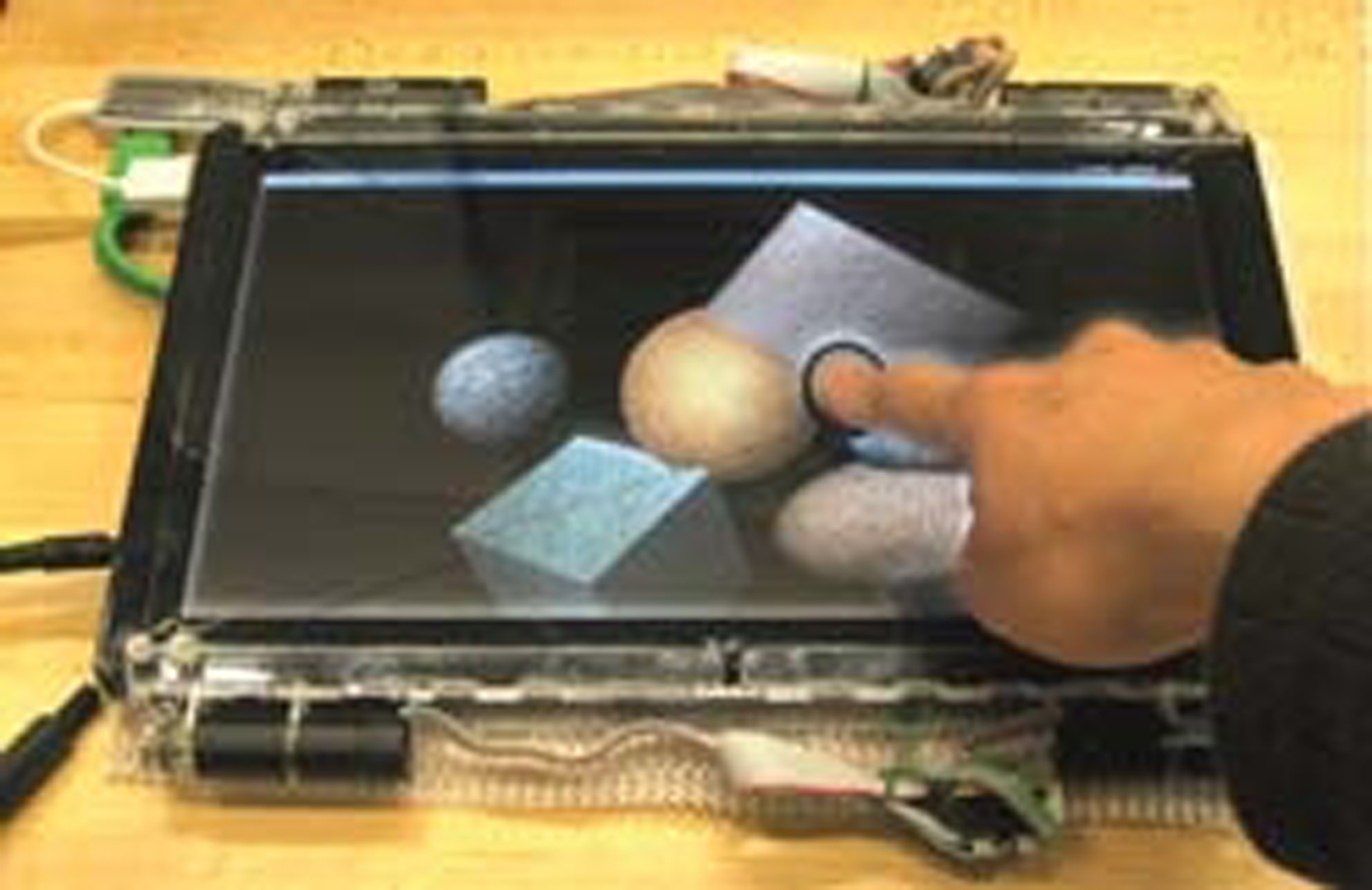“Feel Through Window: Simultaneous Geometry and Texture Display Based on Lateral Force”
Conference:
Experience Type(s):
Title:
- Feel Through Window: Simultaneous Geometry and Texture Display Based on Lateral Force
Organizer(s)/Presenter(s):
Description:
Touching through a screen to a displayed object has been one of a goal of human interface. Several researchers employ vibrations in order to display texture information. However no systems realize to display geometrical shapes and textures. In this research we propose a method that allows the user to feel both large bump and precise textures simultaneously through a touchscreen. Our method employs lateral force and high-frequency (around 1-10kHz) direction-controlled vibration. Vibration, normal to moving direction of finger enables independent display between geometrical and texture information. The technology allows not only geometrical shapes but also textures to be felt.
References:
[1]
Bau, O., Poupyrev, I., Israr, A., and Harrison, C. 2010. TeslaTouch: electrovibration for touch surfaces. In Proceedings of the 23nd Annual ACM Symposium on User Interface Software and Technology, ACM, 283–292.
[2]
Blackshaw, M., DeVincenzi, A., Lakatos, D., Leithinger, D., and Ishii, H. 2011. Recompose: direct and gestural interaction with an actuated surface. In Proceedings of the 2011 annual conference extended abstracts on Human factors in computing systems, ACM, 1237–1242.
[3]
Chubb, E. C., Colgate, J. E., and Peshkin, M. A. 2010. Shiverpad: A glass haptic surface that produces shear force on a bare finger. IEEE Transactions on Haptics 3, 3, 189–198.
[4]
Iwata, H., Yano, H., Nakaizumi, F., and Kawamura, R. 2001. Project FEELEX: adding haptic surface to graphics. In Proceedings of the 28th Annual Conference On Computer Graphics and Interactive Techniques, ACM, 469–476.
[5]
Konyo, M., Yamada, H., Okamoto, S., and Tadokoro, S. 2008. Alternative display of friction represented by tactile stimulation without tangential force. In Haptics: Perception, Devices and Scenarios (Proceedings of 6th International Conference, EuroHaptics 2008), 619–629.
[6]
Kuchenbecker, K., Gewirtz, J., McMahan, W., Standish, D., Martin, P., Bohren, J., Mendoza, P., and Lee, D. 2010. Verrotouch: high-frequency acceleration feedback for telerobotic surgery. Haptics: Generating and Perceiving Tangible Sensations 6191, 189–196.
[7]
Levesque, V., and Hayward, V. 2003. Experimental evidence of lateral skin strain during tactile exploration. In Proceedings of Eurohaptics.
[8]
Minamizawa, K., Kakehi, Y., Nakatani, M., Mihara, S., and Tachi, S. 2012. TECHTILE toolkit – A prototyping tool for design and education of haptic media. In Proceedings of Virtual Reality International Conference (Laval Virtual) 2012.
[9]
Minsky, M. R., Ouh-young, M., Steele, O., Frederick P. Brooks, J., and Behensky, M. 1990. Feeling and seeing: Issues in force display. In Proceedings of the 1990 Symposium on Interactive 3D Graphics.
[10]
Nakatani, M., Kajimoto, H., Sekighuchi, D., Kawakami, N., and Tachi, S. 2004. Pop up!: a novel technology of shape display of 3d objects. In Conference Abstracts and Applications of SIGGRAPH2004, DVD-ROM.
[11]
Piper, B., Ratti, C., and Ishii, H. 2002. Illuminating clay: a 3-d tangible interface for landscape analysis. In Proceedings of the SIGCHI conference on Human factors in computing systems: Changing our world, changing ourselves, ACM, 355–362.
[12]
Poupyrev, I., Nashida, T., Maruyama, S., Rekimoto, J., and Yamaji, Y. 2004. Lumen: interactive visual and shape display for calm computing. In ACM SIGGRAPH 2004 Emerging technologies, ACM, 17.
[13]
Robles-De-La-Torre, G. 2002. Comparing the role of lateral force during active and passive touch: Lateral force and its correlates are inherently ambiguous cues for shape perception under passive touch conditions. In Proceedings of Eurohaptics.
[14]
Romano, J. M., and Kuchenbecker, K. J. 2012. Creating realistic virtual textures from contact acceleration data. IEEE Transactions on Haptics 5, 2, 109–119.
[15]
Saga, S., and Deguchi, K. 2012. Lateral-force-based 2.5-dimensional tactile display for touch screen. In Proceedings of IEEE Haptics Symposium 2012, 15–22.
[16]
Takasaki, M., Tamon, R., Kotani, H., and Mizuno, T. 2008. Pen tablet type surface acoustic wave tactile display integrated with visual information. In Proceedings of IEEE International Conference on Mechatronics and Automation, 364–367.
[17]
Wang, D., Tuer, K., Rossi, M., and Shu, J. 2004. Haptic overlay device for flat panel touch displays. In Proceedings of 12th International Symposium on HAPTICS’04, IEEE, 290.
[18]
Wiertlewski, M., Lozada, J., and Hayward, V. 2011. The spatial spectrum of tangential skin displacement can encode tactual texture. IEEE Transactions on Robotics 27, 3, 461–472.
[19]
Yamamoto, A., Ishii, T., and Higuchi, T. 2004. Electrostatic tactile display for presenting surface roughness sensation. In 2003 IEEE International Conference on Industrial Technology, vol. 2, IEEE, 680–684.





